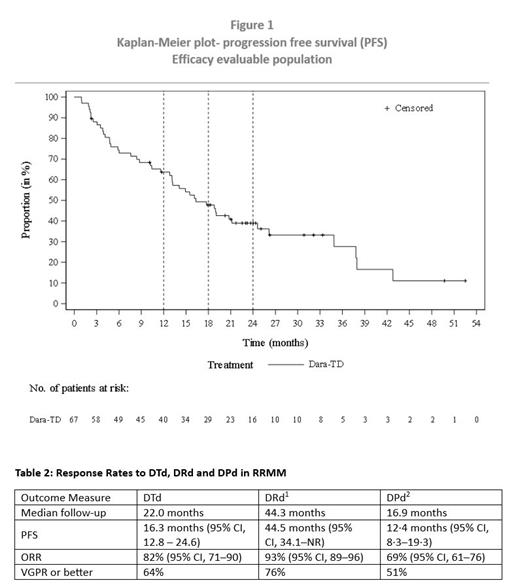Introduction
Myeloma is a plasma cell dyscrasia characterised by a relapsing remitting course. Patients with relapsed / refractory myeloma (RRMM) with prior exposure to proteosome inhibitor and an immunomodulatory agent have a poor prognosis. In the last few years, CD38 antibodies such as daratumumab and isatuximab have revolutionised the treatment of multiple myeloma. They appear synergistic with immunomodulatory drugs; triplet combinations with lenalidomide 1 (DRd) or pomalidomide 2 (DPd) and dexamethasone have been approved for treatment of RRMM. However, patients face high out-of-pocket costs when attempting to access these drugs. There is hence a pressing need to develop combinations which harness the therapeutic potential of CD38 antibodies while preserving synergistic action of triplet combinations.
Methods
This was a multi-national, multi-centre, single arm, phase 2 trial of daratumumab in combination with thalidomide and dexamethasone. Patients with myeloma diagnosed according to the International Myeloma Working Group criteria with measurable disease and relapsing after / refractory to at least one prior line of treatment were eligible for enrolment. Satisfactory organ function (neutrophil count ≥ 1,000/mm 3, platelet ≥ 50,000/mm 3, bilirubin ≤ 1.5 x the upper limit of the normal range (ULN). Alanine aminotransferase (ALT) and aspartate aminotransferase (AST) ≤ 3 x ULN and creatinine clearance ≥ 30ml/min) were pre-requisites for inclusion. Patients with plasma cell leukaemia and those with prior CD38 antibody exposure were excluded.
Patients received daratumumab IV 16mg/kg weekly for weeks 1 - 8, every 2 weeks from weeks 9 - 24 and every 4 weeks from week 25 onwards, thalidomide 100mg daily and dexamethasone 20mg twice a week. Treatment was continued for as long as tolerated and clinically indicated, based on physician assessment, or until disease progression. Thromboprophylaxis was allowed but not mandated.
The primary outcome measure was progression-free survival (PFS), defined as the time from commencement of treatment to disease progression or death from any cause, whichever occurred first. Secondary outcome measures included overall response rate (ORR, the percentage of patients achieving a partial response (PR) or better), overall survival (OS), duration of response (DOR, the time from first evidence of PR or better till disease progression or death, whichever occurred first) and safety, assessed by the frequency and severity of adverse events.
Results
70 patients were recruited. The median age was 66.8 (range 39 - 81) years with 62.7% males. 95.5% of patients had an Eastern Cooperative Oncology Group (ECOG) performance status of 0 or 1. The median number of prior therapies was 2 (range 1 - 6). 91% of patients had prior exposure to bortezomib, while 88% had prior exposure to thalidomide, lenalidomide or both. 50.7% had a prior autologous stem cell transplant.
67 patients completed at least one cycle of treatment. Two died prior to completion of the first cycle, while one withdrew consent and was excluded. Patients were treated for a median of 15.9 (interquartile range, IQR 5.1 - 23) months. 67 (95.7%) patients suffered 544 adverse events, of which 256 (47%) were related to the study treatment, 103 (19%) grades 3-4 and 8 (1%) were fatal. The most common adverse event was infection, which occurred in 26 patients; 4 were fatal. 27 patients had peripheral neuropathy, 25 of which were grade 1 - 2. 14 patients had an infusion reaction, 3 of which required hospitalisation. One patient had a deep vein thrombosis.
At a median follow-up of 22.0 (IQR, 9.9 - 31.0) months, the median PFS was 16.3 (95% CI, 12.8 - 24.6) months (Figure 1). The median OS was 32.5 (95% CI, 25.4 - not reached) months. The ORR was 82.1% (95% CI, 70.8 - 90.4). This ORR was comparable to DRd and DPd (Table 2). Of these, 43 (78%) of patients achieved a very good partial response (VGPR) or better, with 9 (16%) of patients achieving a stringent complete response (sCR). The median DOR was 19.3 (95% CI, 12.2 - 36.5) months.
Conclusion
The combination of daratumumab, thalidomide and dexamethasone is effective in RRMM patients. Thalidomide and dexamethasone are cost-effective drugs which can improve the accessibility of daratumumab-based triplet combinations.
References
1. Bahlis NJ et al. Leukemia. 2020;34(7):1875-1884.
2. Dimopoulos MA et al. Lancet Oncol. 2021;22(6):801-812.
Disclosures
De Mel:Pfizer: Other: advisory board.


This feature is available to Subscribers Only
Sign In or Create an Account Close Modal